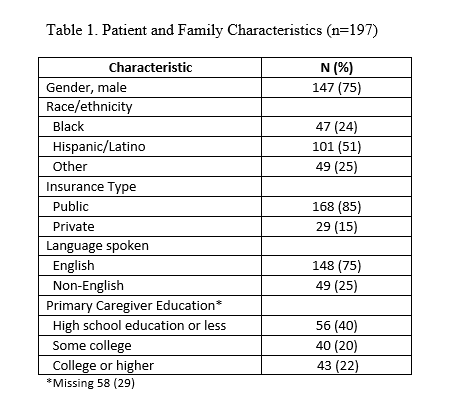Developmental and Behavioral Pediatrics: Autism
Developmental and Behavioral Pediatrics 2
573 - Understanding Disparities in the Diagnosis of Autism Spectrum Disorder
Publication Number: 573.109

Corinna J. Rea, MD, MPH (she/her/hers)
Assistant Professor
Boston Children's Hospital
Boston, Massachusetts, United States
Presenting Author(s)
Background:
Prompt diagnosis and access to services is critical for patients with Autism Spectrum Disorder (ASD) to maximize outcomes. However, there is a need to better understand whether sociodemographic characteristics are associated with timely diagnosis.
Objective:
We aimed to examine associations between child and family characteristics and the age of ASD diagnosis in a primary care population, with a particular interest in identifying sociodemographic disparities.
Design/Methods:
Two trained research assistants conducted a structured chart review of pediatric primary care patients from two large, urban, hospital-affiliated clinics diagnosed with ASD between 9/1/2018-8/31/2021. Only patients who had been seen in the practices from age 18 months or younger were included.
Results:
The final sample included 197 patients. The mean age at time of diagnosis was 36 months. Sociodemographic characteristics assessed include sex, race/ethnicity, insurance type, parental language, and primary caregiver education (Table 1). Eighty-nine percent of patients had been evaluated by Early Intervention (EI), 20% were born premature, and 15% of patients had a nuclear family member with ASD. The mean MCHAT score at 18 months was 4, and at 24 months was 5. In bivariate analysis, language delay, connection with EI, higher 18 and 24 month MCHAT scores, prematurity, and having a nuclear family member with ASD were associated with earlier diagnosis. In multivariate linear regression analysis, caregiver with a high school education or less (v. college or more) was associated with a later age of diagnosis (8.5 months [95% CI: 0.61, 16.40]), while female sex, private insurance (v. public), language delay, connection with EI and higher MCHAT score at age 24 months were associated with an earlier age of diagnosis (-8.00 months [95% CI: -15.71, -0.28]; -9.49 months [95% CI: -18.18, -0.79]; -14.82 months [95% CI: -24.13, -5.52]; -26.35 months [95% CI: -38.03, -14.66]; -0.99 months [95% CI: -1.70, -0.26], respectively). Race/ethnicity was not significantly associated with age of ASD diagnosis.
Conclusion(s):
In this study we found that higher symptom burden, active developmental monitoring and female sex were associated with earlier ASD diagnosis, while lower primary caregiver education and public insurance status, which may represent a proxy for lower socioeconomic status, were associated with a later diagnosis. The findings suggest the need to explore factors contributing to these disparities, including potential biases in the diagnostic process, and the importance of developing interventions to overcome barriers to obtaining a diagnosis.
